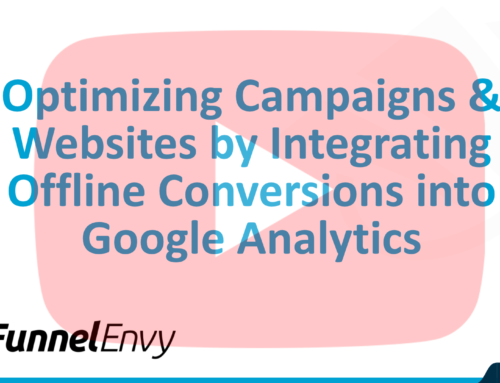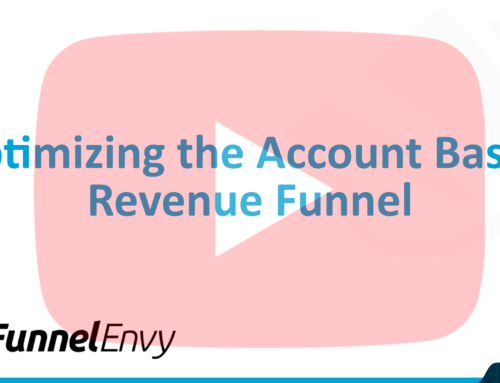You probably don’t have a shortage of data about your customers.
If anything, the challenge is organizing and interpreting it well enough to pull out valuable insights.
How can you turn huge chunks of information into concrete action to better serve your customers and improve your business?
Businesses who do this have a tremendous advantage over their competitors. They make more sales because they do a better job delivering exactly what their customers want: a seamless, user-friendly experience.
Analytics tools tell you where customers come from, their demographics, and what they do on your website. Other technologies, such as marketing automation, layer this data to spot valuable trends.
But there are still plenty of unknowns in how people make the journey all the way from first-time visitors to loyal customers and brand advocates.
What are they thinking along the way?
What information do they need at critical times?
What could you do to make the process smoother?
These are key gaps in the analytics landscapes. Hidden inside those gaps is the story of how people start as strangers and end up as customers – and all their motivations and emotional triggers along the way.
Mapping your customers’ journey can reveal that story…
And there’s no better time to start than now.
Photo Credit: DeathtoStock
The B2B Customer Experience Has Changed Dramatically
Some businesses can list key touch points (interactions between users and their team) off the top of their heads. If their sales cycles are pretty linear, it might only take a few steps to explain how a website visitor becomes a customer.
This happens often in the B2C world. B2C businesses tend to sell relatively inexpensive, simple products and services. Their shorter average sales cycles reflect that.
But things are more dicey in the B2B world. You’re selling high-ticket items with longer commitments attached. The sales cycle – from awareness to information gathering and overcoming objections – could take months or even years to complete.
New technologies and devices are also changing B2B consumer behavior. It’s easier now than ever to jump between different information sources (blogs, competitor websites, review sites, videos, etc.) and devices (PC’s, tablets, smartphones, etc.) before deciding to pull the trigger.
All this leads to non-linear sales cycles. B2B customer experiences are “messy.” A prospect used to give you a call, your sales team would follow up, and after some back and forth you’d close the sale. Now, someone might call you, dig around on your website, scan a few blog posts, then head over to a niche forum before ultimately deciding not to buy based on a negative post.
It’s Time for “Marketing Funnels 2.0”
B2B sales cycles are much wilder and messier than they used to be.
Continuing to view yours with a linear perspective is a recipe to shortchange customers because it just doesn’t reflect how the vast majority of them are behaving.
The traditional concept of a “marketing funnel” is linear – prospects come in at the top, and work their way down as they qualify themselves and the funnel narrows. But limiting your conversion strategies to such a linear template causes you to overlook key touch points and barriers to conversion.
Customer journey maps offer another way to conceptualize changing B2B consumer experiences and generate valuable insights for your business.
In a lot of ways, these customer journey maps are like “funnels 2.0.”
What Is Customer Journey Mapping?
A customer journey map is a visual representation of how customers interact with your business throughout the different phases of the sales cycle.
Here’s one from Dutch service design studio 31Volts:
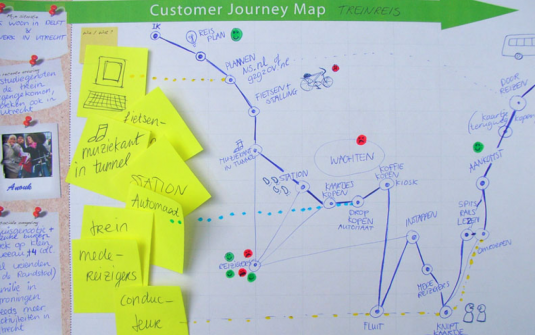
One key difference from typical conversion funnels: customer journey maps are conceived from the customer’s perspective, making sure to incorporate their goals, emotions, and critical information gaps. These elements reflect the messy reality of today’s sales cycles.
The scope of your customer journey map is up to you. It can range from a specific phase in the customer experience (say, information gathering and research) to the full spectrum – everything from first contact to ultimately becoming a loyal customer and brand advocate.
Customer journey maps are built on a foundation of quantitative data. They use qualitative data to connect the dots and flesh out the journey with customer motivations, emotions, and key obstacles and questions along the way.
Unlike traditional marketing funnels (which are linear), customer journey maps can take many different forms. Depending on your business, your map could be an infographic, storyboard, or even a video. Gathering data helps inform which medium would work best.
Beyond different mediums, customer journey maps also incorporate different shapes. Some look like wheels. Others look like flowcharts, timelines, or arcs. I work with one client who helps guide start-up companies through the venture capital process. He envisions the experience as an airplane gathering speed, taking off, and flying for a while before landing safely on another runway.
How It Will Help You
If you’re doing business online, you have access to plenty of powerful information about your customers.
Customer journey mapping helps you make the most of it, offering key insights you won’t find anywhere else.
Here are just a few ways making a customer journey map benefits you:
- Helps you decide which competing business priorities to address first
- Inspires new ideas for marketing, education, and support content
- Reveals how and why customers navigate between different devices, media channels, and departments within your company
- Sparks ideas for new products and services
- Unites different “silos” of your organization under the same banner – delivering the best customer experience
How to Map the Journey
The thought of creating a customer journey map from scratch can seem intimidating…
But it doesn’t need to be.
Here’s how to get started today:
Step 1. Figure Out If You Need Multiple Maps
If you’re offering a variety of products or services, you might be attracting different “types” of customers who don’t have much in common.
In these situations, the concept of customer personas comes in handy.
If you’re appealing to multiple customer personas, there’s no need to try and incorporate all of their experiences into a single customer journey map. You’ll just end up with a complicated, overwhelming mess!
Sound familiar?
Consider separating people’s experiences across different customer journey maps. If your customers are more uniform in nature, on the other hand, sticking with one persona You don’t have to worry about this if your customers are more uniform in nature.
Step 2. Break Down the Typical Customer Experience into Phases
You probably already have at least a general idea of how someone goes from finding out about your business for the first time to becoming a loyal customer. Now it’s time to break down that journey – even if it takes months or years – into a handful of broad phases customers pass through along the way.
These phases will act as “landmarks” to put on your customer journey map.
Typical phases of a customer experience might look like this:
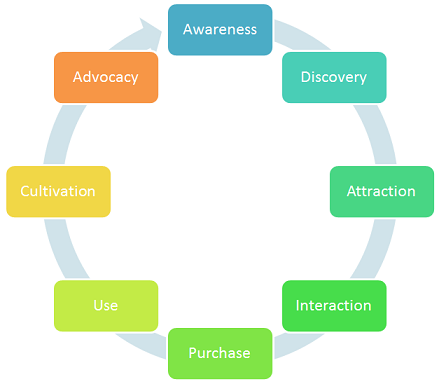
Image credit: CustomerThink
Or this:
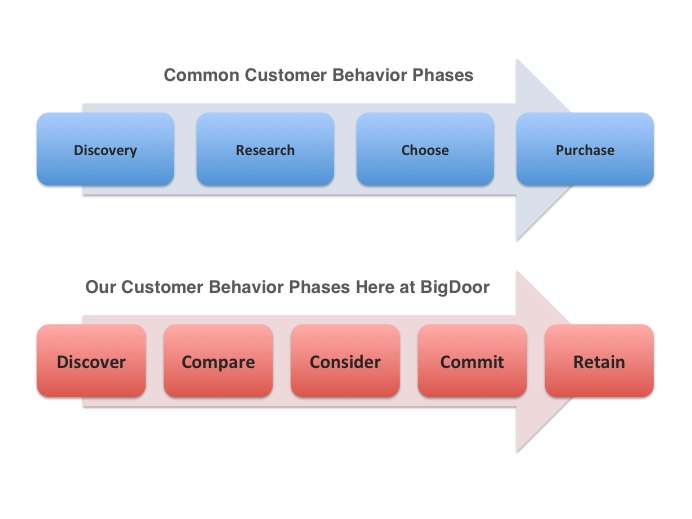
Image credit: The BigDoor Blog
Don’t stress out about the labels you choose or whether you’re getting everything just right (you can even copy the examples above if they make sense for your business). The key is to just get some kind of basic structure in mind. You can always tweak it later as your map evolves.
Once you’ve broken down the typical customer journey into a handful of phases (ranging from awareness all the way to loyal business and brand advocacy), it’s time to flesh things out a little further.
Step 3. Pinpoint Key Customer Motivations and Questions During Each Phase
Remember: your journey map is from the customer’s perspective. That means their needs and desires will be top of mind. This customer-first focus will ultimately come back to help you. Serve your customers better, and they’ll return the favor in more sales and revenue.
So let’s start there. First, figure out what your customer needs and wants during each phase of their experience. Then, pinpoint any touch points you’ve already created to address those needs. You might find gaps, but that’s awesome! Those potential areas for improvement just show that this process is already paying off.
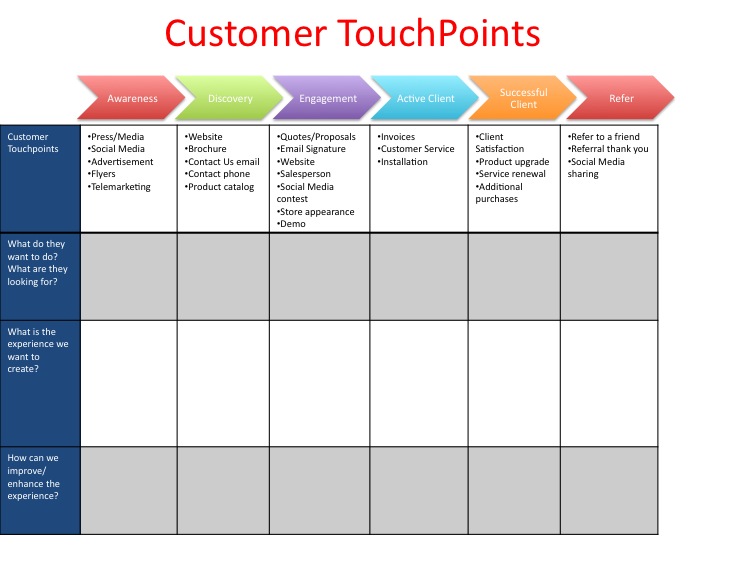
Image credit: Score.org
The touch points you’ve created could be personal or virtual. Anything from a one-on-one phone call with a sales rep to a PDF you delivered via email marketing is fair game. Also, touch points don’t all have to occur on your website. Many happen off-site, as potential customers gather information and visit review websites and your social media platforms.
Identify all the touch points you have in place and take note of any key interactions. Then, arrange these depending on which customer needs and wants they serve to arrive at a basic road map.
Step 4. Turn to Data to Flesh Things Out
Now that you have a basic structure (phases) and key touch points laid out, it’s time to flesh out your map with some data.
Data for customer journey maps comes in two flavors, quantitative and qualitative.
Quantitative Data
Quantitative data is numerical information that sheds light on your customers’ behavior. Here are just a few places where it can come from:
- Analytics platforms
- Call tracking software
- Customer relationship management (CRM) software
- Email marketing platforms
- Live chat software
- Marketing automation tools
Qualitative Data
Qualitative data is more subjective than quantitative data. It encompasses softer or more emotional (but no less valuable) information from places like:
- Blog comments
- Conversations via social media
- Feedback
- Online surveys
- Testimonials
Review the data you have. You’ll layer this information onto the phases and touch points within them, adding more detail to the customer journey map just like topography and landscape elements add more detail to physical maps.
Step 5. Decide Which Media to Use and Your Map’s Shape
After you’ve decided on a basic structure and supported it with data, it’s time to figure out which media to use for your map and how to display it.
Like I mentioned earlier, your options here are only limited by your imagination. It might be easier for your business to conceptualize the customer journey in an arc-shaped infographic, while someone else prefers a storyboard in timeline form. It depends on the behavior of your specific customers.
Here’s an infographic from a broadband provider:
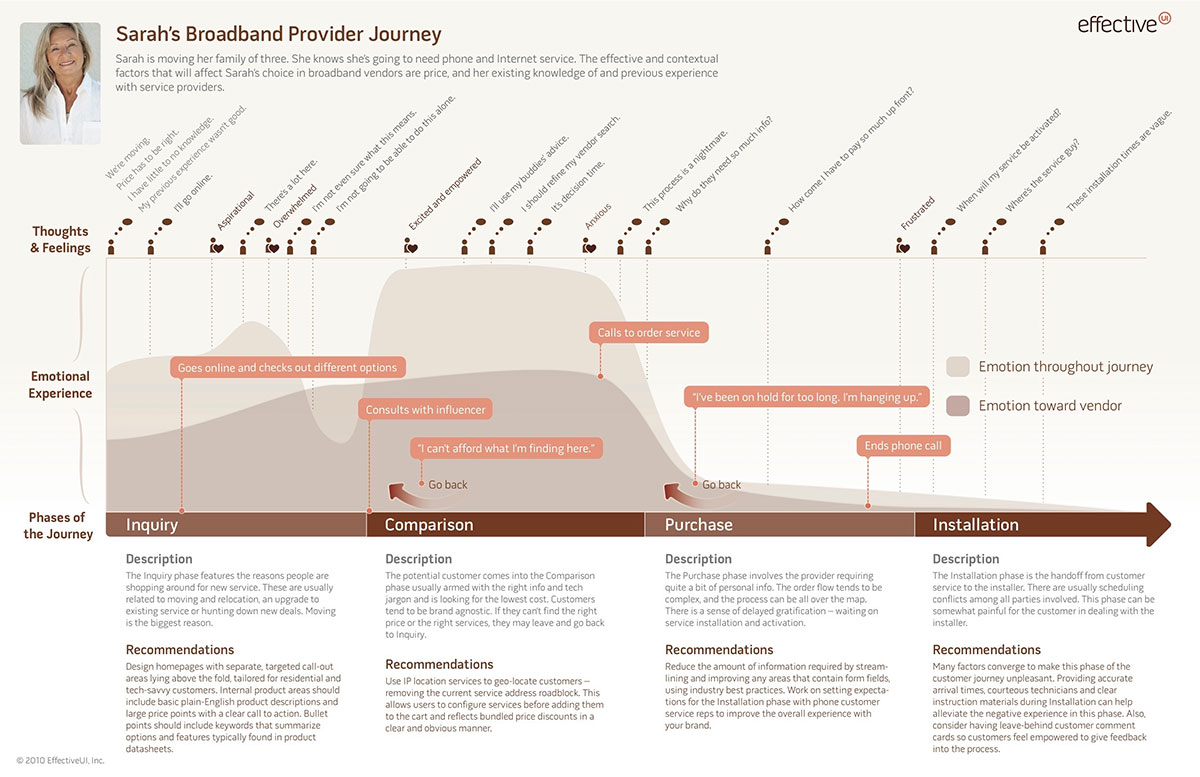
Image credit: Smashing Magazine
And here’s a completely different look from Live|Work studio:
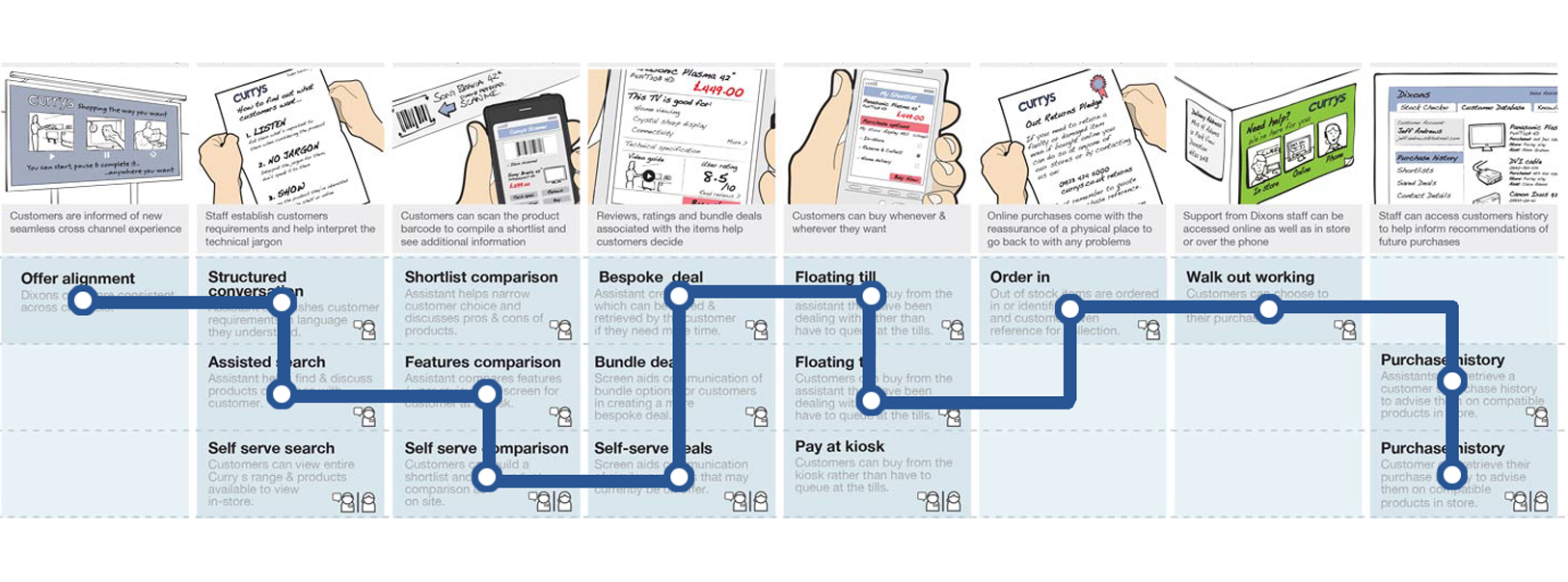
Don’t worry about things looking a little “messy” or non linear. That’s exactly the point! Don’t get too bogged down in design details. Focus on key touch points and threshold “moments of truth” – where users make key decisions whether to continue their relationships with you… or look elsewhere.
It’s probably worth it to have a designer put your customer journey map together so you end up with a professional end product. You’ll be able to hang this up in your office and use it to communicate with your team.
A customer journey map should offer a nice bird’s-eye view of the typical customer experience. Focus on key interactions that propel them through the sales cycle. Ideally, you’ll want to end up with a one-pager or short video your team can reference and interpret quickly.
Step 6. Evolve and Adapt
Keep collecting feedback and making improvements based on the insights you gain from making your first customer journey map. Your role is a lot like the road crew filling potholes, adding new lanes, road signs, etc. to reflect a better understanding of the journey and make it as smooth as possible.
Over time, your customer journey map will become an important element of your CRO strategy. The principles are the same: gradual, continuous optimization will lead to exponentially better results.
Deliver the Seamless Experience Your Customers Crave
Your first customer journey map might not be beautiful or perfectly designed…
But it will be useful.
Just the process itself – sitting down and forcing yourself to gather data and sketch it out – forces you to put your customers first. That alone can lead to some game-changing insights.
There’s no pressure to get everything right the first time around. Your customer journey map will evolve with more information and attention over time. Picture one of those snazzy GPS programs that re-routes you when there’s traffic or construction.
That’s exactly what a customer journey map will help you do. With understanding, you’ll re-route customers to a smoother, more satisfying experience.
Your customers aren’t shopping from A to B to C anymore. The better you understand how the process unfolds, the better you can shore up weak points and deliver an unparalleled experience that will win serious business.
In this world of information overload and so many ways to acquire it, it pays to put yourself in your customer’s shoes…
Mapping their journeys helps you do just that!
Have you made a customer journey map before? If so, what did you learn about your business? Leave a comment below and share your experience!



